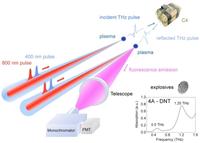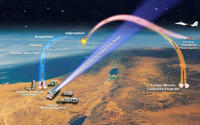-
Bricks made from paper waste

Spanish researchers have mixed waste from the paper industry with ceramic material used in the construction industry; the result is a brick that has low thermal conductivity meaning it acts as a good insulator; its mechanical resistance, however, still requires improvement
-
-
Fuels, household chemicals made from sugar
Scientists at the University of Manchester have identified a biocatalyst which could produce chemicals found in ice-cream and household items such as soap and shampoo — possibly leading to the long-term replacement of chemicals derived from fossil fuels
-
-
New, quick way to ID people exposed to dirty bomb, radioactive radiation
Research conducted by scientists from the Berkeley Lab could lead to a blood test that detects if a person has been exposed to radiation, measures their dose, and separates people suffering from inflammation injuries — all in a matter of hours
-
-
Deployable RF data backbone which matches fiber optic capacity
DARPA envisions 100-Gigabit per second RF communications link between airborne and ground assets; the goal is for the data link to achieve a range greater than 200 kilometers between airborne assets and a range greater than 100 kilometers between an airborne asset (at 60,000 feet) and the ground
-
-
U.S. Navy scientists honored for significant portfolio of newly patented discoveries and inventions

U.S. Navy scientists and engineers in 2012 once again had the world’s most significant government portfolio of newly patented discoveries and inventions, according to a November report published by the Institute of Electrical & Electronics Engineers (IEEE)
-
-
Technology emulates the Blind Cave Fish to help underwater vessels navigate with ease
Scientists have invented a “sense-ational” device, similar to a string of feelers found on the bodies of the Blind Cave Fish, which enables the fish to sense their surrounding and so navigate easily; using a combination of water pressure and computer vision technology, the sensory device is able to give users a 3-D image of nearby objects and map its surroundings
-
-
Terahertz waves for explosives detection

The chips generate and radiate high-frequency electromagnetic waves, called terahertz (THz) waves, which fall into a largely untapped region of the electromagnetic spectrum — between microwaves and far-infrared radiation — and which can penetrate a host of materials without the ionizing damage of X-rays; when incorporated into handheld devices, the new microchips could enable a broad range of applications in fields ranging from homeland security to wireless communications to health care, and even touchless gaming
-
-
Revamped DARPA inventor mentorship programs increases funding
DARPA says it wants to ensure that young scientists with novel ideas which may advance U.S. national security receive the funding and mentorship needed to investigate them; as the DARPA Young Faculty Award (YFA) program enters its seventh year, changes in scope mean that 2013 recipients can expect higher levels of funding — up to $1 million available for elite young researchers — for a potentially longer duration in a program that has been reworked to involve even more direct interaction with DARPA program managers
-
-
The potential for self-driving cars in the U.K.
Researchers explored what it would take for driverless vehicles to become commonplace on U.K. roads; they highlight the potential benefits of self-driving cars, such as increased road safety and less traffic, but stress that a range of barriers need to be overcome before people buy them en masse
-
-
Israel to test advanced Arrow 3 anti-missile missile

The official in charge of developing Israel’s missile defense system said yesterday that in the coming days Israel would conduct a test of the advanced Arrow 3 missile; the Arrow 3 has been developed to shoot down Iranian ballistic missiles on their way to Israel; the Arrow 3 has been designed to intercept missiles carrying nuclear warheads – and intercept them outside the atmosphere
-
-
Technology transfer from U.S. federal laboratories to private entities, other governments
In 2010 the eleven U.S. federal laboratories had more than 18,000 active collaborative relationships with private entities and other government agencies, disclosed more than 4,700 inventions, submitted 1,830 patent applications, and received 1,143 patents
-
-
New sensor detects undetonated bombs on sea floor
More than ten million acres of the world’s coastal waters are contaminated by undetonated explosives, according to the U.S. government; typically these small explosives rust and corrode at sea, making them even more dangerous; scientists have developed a sensor to detect undetonated explosives on the sea floor; the sensor is based on technology used to find mineral deposits underground
-
-
Technology to help weather bushfires, floods and more
Natural disasters have increased in severity and frequency in recent years; in 2010, 385 natural disasters affected 217 million people worldwide at a cost to the global economy of $123.9 billion; there is an on-going research into digital technologies and services for disaster planning, preparation, rescue, and recovery; these technologies can help emergency services better manage natural disasters and minimize their effects on people, infrastructure, and the environment
-
-
Israel successfully tests David’s Sling mid-range missile defense system
During the just-ended Operation Pillar of Defense, Israel made military history by successfully employing a missile defense system to protect the country’s population: during the 8-day war, Hamas and Islamic Jihad launched 1,506 rockets and missiles at Israeli towns and cities; of those, 1,057 fell harmlessly in empty fields, but 449 were headed toward populated centers; of the 449, Israel’s Iron Dome system intercepted 421, and 28 hit buildings, killing five; yesterday Israel announced the successful test of David’s Sling, a mid-range missile defensive system; the system is designed to protect against missile with a range of up to 180 miles, like the missiles in the hands of Syria and Hezbollah
-
-
Improved technology to detect hazardous chemicals
Scientists have developed a system quickly to detect trace amounts of illegal drugs, explosives, pollutants in rivers, or nerve gases released into the air; the new system can pick out a single target molecule from 10,000 trillion water molecules within milliseconds, by trapping it on a self-assembling single layer of gold nanoparticles
-
More headlines
The long view
New Technology is Keeping the Skies Safe
DHS S&T Baggage, Cargo, and People Screening (BCP) Program develops state-of-the-art screening solutions to help secure airspace, communities, and borders
Factories First: Winning the Drone War Before It Starts
Wars are won by factories before they are won on the battlefield,Martin C. Feldmann writes, noting that the United States lacks the manufacturing depth for the coming drone age. Rectifying this situation “will take far more than procurement tweaks,” Feldmann writes. “It demands a national-level, wartime-scale industrial mobilization.”
How Artificial General Intelligence Could Affect the Rise and Fall of Nations
Visions for potential AGI futures: A new report from RAND aims to stimulate thinking among policymakers about possible impacts of the development of artificial general intelligence (AGI) on geopolitics and the world order.
Keeping the Lights on with Nuclear Waste: Radiochemistry Transforms Nuclear Waste into Strategic Materials
How UNLV radiochemistry is pioneering the future of energy in the Southwest by salvaging strategic materials from nuclear dumps –and making it safe.
Model Predicts Long-Term Effects of Nuclear Waste on Underground Disposal Systems
The simulations matched results from an underground lab experiment in Switzerland, suggesting modeling could be used to validate the safety of nuclear disposal sites.
